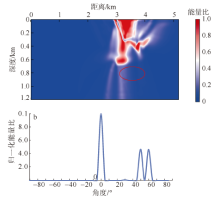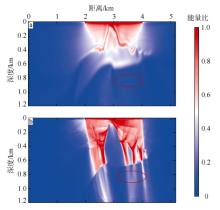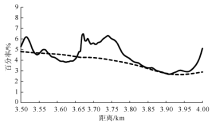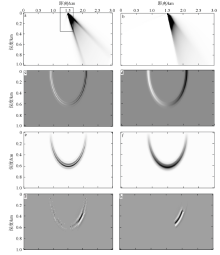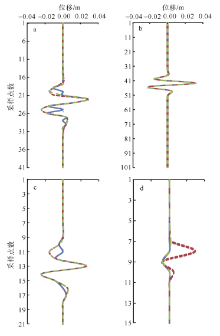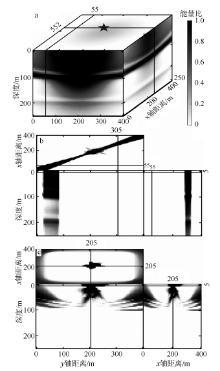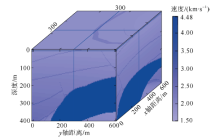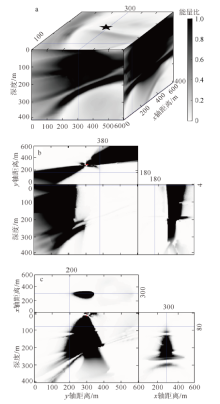| [1] |
陈生昌, 马在田, 吴如山, 2007. 波动方程双程地下方向照明分析[J]. 同济大学学报(自然科学版), 35(5): 681-684, 704.
|
|
CHEN SHENGCHANG, MA ZAITIAN, WU RUSHAN, 2007. Two-way subsurface directional illumination analysis by wave equation[J]. Journal of Tongji University (Natural Science), 35(5): 681-684, 704 (in Chinese).
|
| [2] |
董良国, 吴晓丰, 唐海忠, 等, 2006. 逆掩推覆构造的地震波照明与观测系统优化[J]. 石油物探, 45(1): 40-47.
|
|
DONG LIANGGUO, WU XIAOFENG, TANG HAIZHONG, et al, 2006. Seismic wave illumination for overthrust nappe structures and optimal seismic survey design[J]. Geophysical Prospecting for Petroleum, 45(1): 40-47 (in Chinese).
|
| [3] |
冯伟, 王华忠, 吴如山, 等, 2004. 面向目标控制照明的合成波源偏移[J]. 石油物探, 43(3): 223-228.
|
|
FENG WEI, WANG HUAZHONG, WU RUSHAN, et al, 2004. The migration of synthetic waves for target-oriented controlled illumination[J]. Geophysical Prospecting for Petroleum, 43(3): 223-228 (in Chinese).
|
| [4] |
雷涛, 顾汉明, 李列, 等, 2014. 面向目标靶区的双程波动方程地震定向照明分析[J]. 石油物探, 53(4): 437-443.
|
|
LEI TAO, GU HANMING, LI LIE, et al, 2014. Target-oriented seismic directional illumination analysis based on two-way acoustic wave equation[J]. Geophysical Prospecting for Petroleum, 53(4): 437-443 (in Chinese).
|
| [5] |
李万万, 2008. 基于波动方程正演的地震观测系统设计[J]. 石油地球物理勘探, 43(2): 134-141.
|
|
LI WANWAN, 2008. Design of seismic geometry based on wave equation forward simulation[J]. Oil Geophysical Prospecting, 43(2): 134-141 (in Chinese).
|
| [6] |
吕公河, 尹成, 周星合, 等, 2006. 基于采集目标的地震照明度的精确模拟[J]. 石油地球物理勘探, 41(3): 258-261.
|
|
LYU GONGHE, YIN CHENG, ZHOU XINGHE, et al, 2006. Precious simulation of seismic illumination based on acquired targets[J]. Oil Geophysical Prospecting, 41(3): 258-261 (in Chinese).
|
| [7] |
裴正林, 2008. 波动方程地震定向照明分析[J]. 石油地球物理勘探, 43(6): 645-651.
|
|
PEI ZHENGLIN, 2008. Analysis on wave equation seismic directional illumination[J]. Oil Geophysical Prospecting, 43(6): 645-651 (in Chinese).
|
| [8] |
秦广胜, 蔡其新, 汪功怀, 等, 2010. 基于叠前成像的三维地震观测系统设计[J]. 地球物理学进展, 25(1): 238-248.
|
|
QIN GUANGSHENG, CAI QIXIN, WANG GONGHUAI, et al, 2010. 3D seismic geometry design based on pre-stack imaging[J]. Progress in Geophysics, 25(1): 238-248 (in Chinese).
|
| [9] |
孙伟家, 符力耘, 碗学检, 2007. 基于相位编码的地震照明度分析[J]. 石油地球物理勘探, 42(5): 539-543.
|
|
SUN JIAWEI, FU LIYUN, WAN XUEJIAN, 2007. Phase encoding-based seismic illumination analysis[J]. Oil Geophysical Prospecting, 42(5): 539-543 (in Chinese).
|
| [10] |
孙伟家, 符力耘, 胡善政, 等, 2011. 基于相位编码的Fourier变换波动方程三维地震照明分析[J]. 地球物理学进展, 26(4): 1249-1257.
|
|
SUN WEIJIA, FU LIYUN, HU SHANZHENG, et al, 2011. 3D Fourier transform wave-equation-based seismic illumination analysis with phase encoding[J]. Progress in Geophysics, 26(4): 1249-1257 (in Chinese).
|
| [11] |
温书亮, 尹成, 李绪宣, 等, 2011. 地震照明分析技术在深海地震数据采集设计中的应用[J]. 石油地球物理勘探, 46(4): 506-512.
|
|
WEN SHULIANG, YIN CHENG, LI XUXUANG, et al, 2011. Seismic illumination method and its application in seismic geometry design in deep waters[J]. Oil Geophysical Prospecting, 46(4): 506-512 (in Chinese).
|
| [12] |
徐峰, 陈立, 苏悦, 等, 2012. 基于目的层反射能量二次导数的炮检距设计[J]. 西南石油大学学报(自然科学版), 34(2): 72-78.
|
|
XU FENG, CHEN LI, SU YUE, et al, 2012. An offset design based on second derivative of target stratum energy[J]. Journal of Southwest Petroleum University (Science & Technology Edition), 34(2): 72-78 (in Chinese).
|
| [13] |
杨敬磊, 李振春, 叶月明, 等, 2008. 地震照明叠前深度偏移方法综述[J]. 地球物理学进展, 23(1): 146-152.
|
|
YANG JINGLEI, LI ZHENCHUN, YE YUEMING, et al, 2008. Review of seismic illumination pre-stack depth migration methods[J]. Progress in Geophysics, 23(1): 146-152 (in Chinese).
|
| [14] |
朱金平, 董良国, 程玖兵, 2011. 基于地震照明、面向勘探目标的三维观测系统优化设计[J]. 石油地球物理勘探, 46(3): 339-348.
|
|
ZHU JINPING, DONG LIANGGUO, CHENG JIUBING, 2011. Target-oriented 3D seismic optimal geometry design based on seismic illumination[J]. Oil Geophysical Prospecting, 46(3): 339-348 (in Chinese).
|
| [15] |
JIN SHENGWEN, WALRAVEN D, 2003. Wave equation GSP prestack depth migration and illumination[J]. The Leading Edge, 22(7): 606-610.
|
| [16] |
LECOMTE I, GELIUS L J, 1998. Have a look at the resolution of prestack depth migration for any model, survey and wavefields[C]. New Orleans: SEG Technical Program Expanded Abstracts: 1112-1115.
|
| [17] |
LIU FAQI, STOLT R H, HANSON D W, et al, 2002. Plane wave source composition: an accurate phase encoding scheme for prestack migration[C]. Salt Lake City: SEG Technical Program Expanded Abstracts: 1156-1159.
|
| [18] |
LIU SHOUWEI, GENG JIANHUA, FENG WEI, 2005. Controlled illumination and seismic acquisition geometry for target-oriented imaging[J]. Applied Geophysics, 2(4): 230-234.
|
| [19] |
RICKETT J E, 2003. Illumination-based normalization for wave-equation depth migration[J]. Geophysics, 68(4): 1371-1379.
|
| [20] |
WU RUSHAN, CHEN LING, 2002. Mapping directional illumination and acquisition-aperture efficacy by beamlet propagators[C]. Salt Lake City: SEG Technical Program Expanded Abstracts: 1352-1355.
|
| [21] |
WU RUSHAN, CHEN LING, 2006. Directional illumination analysis using beamlet decomposition and propagation[J]. Geophysics, 71(4): S147-S159.
|
| [22] |
XIE XIAOBI, JIN SHENGWEN, WU RUSHAN, 2006. Wave-equation-based seismic illumination analysis[J]. Geophysics, 71(5): S169-S177.
|
| [23] |
XIE XIAOBI, YANG HUI, 2008. A full-wave equation based seismic illumination analysis method[C]. Rome: 70th conference & Exhibition, European Association of Geoscientists & Engineers, Extended Abstracts: 284.
|
| [24] |
YOON K, GUO MANHONG, CAI JUN, et al, 2011. 3D RTM angle gathers from source wave propagation direction and dip of reflector[C]. San Antonio: SEG Technical Program Expanded Abstracts: 3136-3140.
|
| [25] |
YOON K, MARFURT K J, 2006. Reverse-time migration using the Poynting vector[J]. Exploration Geophysics, 37(1): 102-107.
|
 ), Minghui ZHAO1(
), Minghui ZHAO1( ), Min ZHANG2, Guoquan YANG2
), Min ZHANG2, Guoquan YANG2






